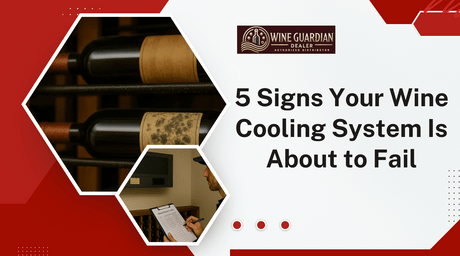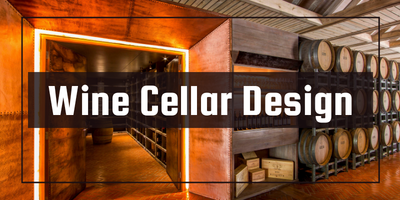
5 Signs Your Wine Cooling System Is About to Fail
Don’t wait for a costly surprise. Wine Guardian Dealer breaks down the top 5 signs your wine cooling system may be failing — and how to fix it before damage...
Jim Hopper
In Stock & Ready to Ship – Order Your Wine Cooling System Today!
Free Wine Cellar Expert Consultation | 📞 Call 1-800-260-1712
Start with a free expert consult—cooling system sizing, racking options, and no upsells.

Build your dream wine cellar—without costly mistakes or guesswork.
By Jim Hopper, Wine Cooling Expert
A well-maintained wine cellar is essential for preserving the quality, taste, and value of your wine collection. The key to maintaining the optimal storage environment is choosing the right wine cellar cooling unit that ensures a constant temperature for wine preservation. Additionally, maintaining the optimal relative humidity level is crucial to protect the quality of your wine.
But with so many options available—split cooling systems, through-the-wall units, and ducted cooling systems—how do you know which one is best for your wine cellar?
In this guide, based on our full Wine Cooling System Comparisons: Find the Best Fit, we’ll walk you through everything you need to know to select the right wine cooling system, ensuring temperature and humidity control for perfect wine aging.

Unlike standard air conditioners, a wine cellar cooling system is a specialized air conditioning unit essential for maintaining the ideal temperature and humidity within a wine cellar. It is designed to:
✅ Maintain a stable temperature (typically 55°F-58°F).
✅ Regulate humidity levels (between 50-70%). Humidity levels below 50% can lead to corks drying out and wine spoilage.
✅ Prevent corks from drying out in dry climates.
✅ Protect your wine collection from temperature fluctuations.
Without a proper cooling system, wine can age too quickly, lose its flavor profile, or develop off flavors due to excess moisture loss.
Your wine cellar’s size determines the cooling unit’s BTU rating.
🔹 Small cellars (up to 500 cubic feet): A through-the-wall cooling unit may be sufficient. These units are perfect for wine enthusiasts with a limited wine collection and space. They are easy to install and maintain, providing a cost-effective solution for maintaining the optimal temperature and humidity levels necessary for wine storage.
🔹 Medium cellars (500-1,500 cubic feet): Consider a split cooling system. These systems are ideal for those who have a moderate-sized wine collection and require more precise temperature control. Split systems offer flexibility in installation, allowing the condenser to be placed outside the wine room, significantly reducing noise levels. This setup is beneficial for wine cellars located near living spaces, ensuring a quiet environment while maintaining the perfect conditions for wine aging.
🔹 Large cellars (1,500+ cubic feet): A ducted cooling unit provides even air distribution. These units are best suited for large or luxury wine cellars with extensive wine collections. Ducted systems offer superior temperature and humidity control, ensuring every part of the cellar maintains consistent conditions. They are discreet and ultra-quiet, seamlessly integrating with the cellar's design without compromising on performance. Investing in a ducted cooling unit is ideal for serious wine collectors who require the highest standard of wine storage conditions.
📌 Tip: Always measure the cubic footage of your wine storage area before selecting a cooling unit.
For optimal performance, your wine cellar must be properly insulated and cooled to maintain consistent temperature and humidity levels. This is essential to store wine cellar properly. Direct sunlight can cause temperature spikes and UV damage to wine.
✔ Vapor barrier: Prevents humidity fluctuations. ✔ High R-value insulation: Maintains consistent temperature.
💡 Why it matters: Without proper insulation, even the best wine cooling system will struggle to maintain the right conditions.
If you live in a hot, dry climate, your wine cellar cooling unit should include: In dry climates, it is essential to add moisture back into the air in wine cellars.
✅ Integrated humidification system to prevent corks from drying out.
✅ Temperature and humidity control for consistent conditions.
✅ Proper ventilation to allow for moist air regulation. Wine cellar cooling systems alone cannot add humidity; a separate humidifier is necessary.

When addressing wine cellar cooling in dry climates, achieving the right balance of temperature and humidity is vital. The arid environment can lead to corks drying out, resulting in wine spoilage and flavor loss. To counteract this, incorporating a wine cellar humidifier into your cooling system is crucial. This addition helps introduce moisture into the ambient air, ensuring your wine collection remains in optimal conditions.
Temperature and Humidity Control: Select a cooling system that provides both temperature and humidity control. Split cooling systems are particularly suitable for these conditions, offering flexible installation options and precise climate control. By positioning the condensing unit outside the wine room, these systems minimize noise and maintain a stable environment for your wine bottles.
Insulation and Construction: For wine enthusiasts residing in dry climates, it's also important to focus on the insulation and construction of the wine cellar. Proper insulation, using high R-value materials, and a vapor barrier are crucial to prevent temperature fluctuations and excessive moisture loss. This not only preserves the quality of your wine but also enhances the energy efficiency of your cooling unit.
Additional Measures: In addition to utilizing a wine cellar humidifier, consider installing exterior-grade doors and double-paned glass to further seal the cellar and maintain consistent temperature and humidity levels. These measures will safeguard your wine collection from the challenges posed by dry climates, ensuring your wine ages gracefully without developing off flavors.
Ultimately, the right combination of cooling systems, humidification, and insulation will provide the stable environment necessary for preserving your wine's quality and value in dry climates. By investing in the appropriate wine cooling systems, you can enjoy your wine collection at its best, regardless of the external climate conditions.
📌 Tip: Using a wine cellar humidifier can help introduce moisture and maintain optimal humidity levels. Integrated wine room humidifiers distribute moisture evenly throughout the cellar air.
If your wine room is near a living space, choose a quiet cooling system.
Through-the-wall systems are affordable but can be noisy.
Split cooling systems offer noise reduction by placing the condensing unit outside.
💡 Pro Tip: Ensure your wine storage area has proper ventilation to prevent warm air buildup.
Each cooling system has unique advantages. Here’s how they compare:

✅ Best for small to mid-sized wine cellars.
✅ Easy to install—fits between wall studs.
✅ No ductwork or HVAC technician required.
📌 Considerations: Louder than split systems, but more affordable.
These units are perfect for wine enthusiasts who are just starting to build their wine collection and need an efficient yet cost-effective solution to maintain the ideal wine storage environment. The straightforward installation process makes them a popular choice for those who prefer a DIY approach, allowing you to have your wine cellar up and running with minimal hassle. Additionally, through-the-wall cooling units are designed to maintain a consistent temperature and humidity level, which is crucial for preventing spoilage and preserving the quality of your wines.

✅ Allows for flexible installation with remote condensers.
✅ Ideal for noise reduction & efficiency.
✅ Better temperature control for large wine cellars.
📌 Considerations: Requires professional installation.
Split systems offer superior flexibility and are ideal for homeowners who prioritize a quiet environment. With the condenser located outside the wine room, these units significantly reduce noise, making them perfect for cellars situated near living spaces. They provide excellent temperature and humidity control, ensuring that your wines age gracefully without the risk of temperature fluctuations. The professional installation required for split systems ensures that the unit is set up correctly for optimal performance, providing peace of mind for serious wine collectors.

✅ Fully integrated with ductwork—even air distribution.
✅ Excellent for large or luxury wine cellars.
✅ Discreet & ultra-quiet operation.
📌 Considerations: Higher upfront cost but best for long-term efficiency.
Ducted cooling units are the premium choice for those who demand the highest standards in wine storage. These systems are seamlessly integrated into the cellar's design, providing even air distribution throughout the space. This ensures that every bottle in your collection is stored under optimal conditions, enhancing the aging process and preserving the wine's value. While the initial investment is higher, the long-term benefits of energy efficiency and superior climate control make ducted systems a worthwhile investment for dedicated wine enthusiasts. Their discreet and quiet operation ensures that the aesthetic and ambiance of your wine cellar remain undisturbed, allowing you to enjoy your collection in a serene environment.
📌 Considerations: Higher upfront cost but best for long-term efficiency.
✔ SEER-rated cooling units – Energy-efficient operation.
✔ Smart temperature control – Adjusts automatically.
✔ Humidity control – Prevents excess moisture loss.
A high-end cooling unit may cost more upfront but saves on energy bills.
Compare initial investment vs. operational efficiency.
📌 Tip: Investing in an energy-efficient cooling unit ensures optimal wine aging while reducing electricity costs.
Here are our top picks based on performance, efficiency, and reliability:
✅ Wine Guardian TTW018 – Compact through-the-wall unit, perfect for small to mid-sized cellars.
✅ Wine Guardian D025 – A ducted cooling system with low energy consumption.
✅ Wine Guardian DS050 – A high-capacity split system for extensive wine collections.
✔ Some units are plug-and-play (self-contained).
✔ Split cooling systems require expert installation.
🛠 Clean filters regularly for optimal performance.
🛠 Check for leaks or excess moisture to prevent damage.
🛠 Ensure proper ventilation for efficient airflow.
At Wine Guardian Dealer, we offer:
🔹 A curated selection of Wine Guardian’s best cooling units.
🔹 Expert guidance to help you choose the right system.
🔹 Competitive pricing & transparent policies.
🔹 Warranty-backed products straight from the manufacturer.
When you choose Wine Guardian Dealer, you’re investing in quality, reliability, and expertise.
Choosing the right wine cellar cooling systems is essential for preserving wine quality and ensuring the proper aging process.
📌 Explore our collection of top-rated wine cooling units today!📞 Still unsure? Speak with an expert for personalized recommendations!
The right cooling unit size depends on the cubic footage of your wine cellar.
Prices vary based on nunit type, size, and features.
Ducted cooling systems integrate with ventilation. Split systems separate the condenser for quieter operation.
Maintaining specific temperature and humidity levels is crucial for ensuring that wine ages gracefully. Proper control prevents spoilage and preserves the quality and flavor of fine wines, ultimately impacting the wine's value as it ages.
🛒Shop our most-loved Wine Guardian cooling systems today.
🛠️Protect your wine with the most trusted systems on the market.
❤️Tested, reviewed, and loved by serious collectors like you.